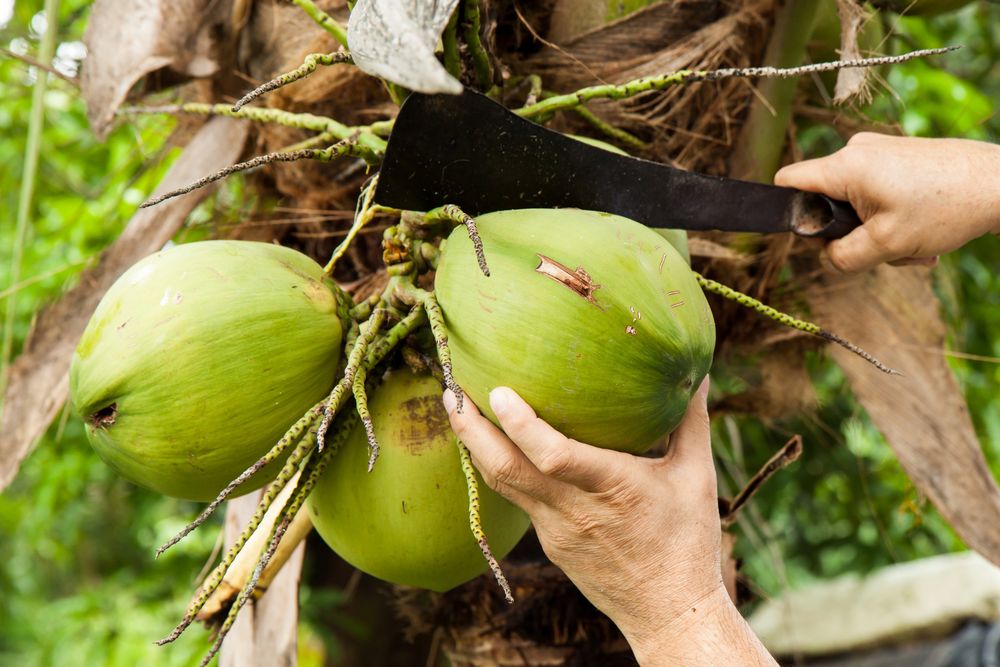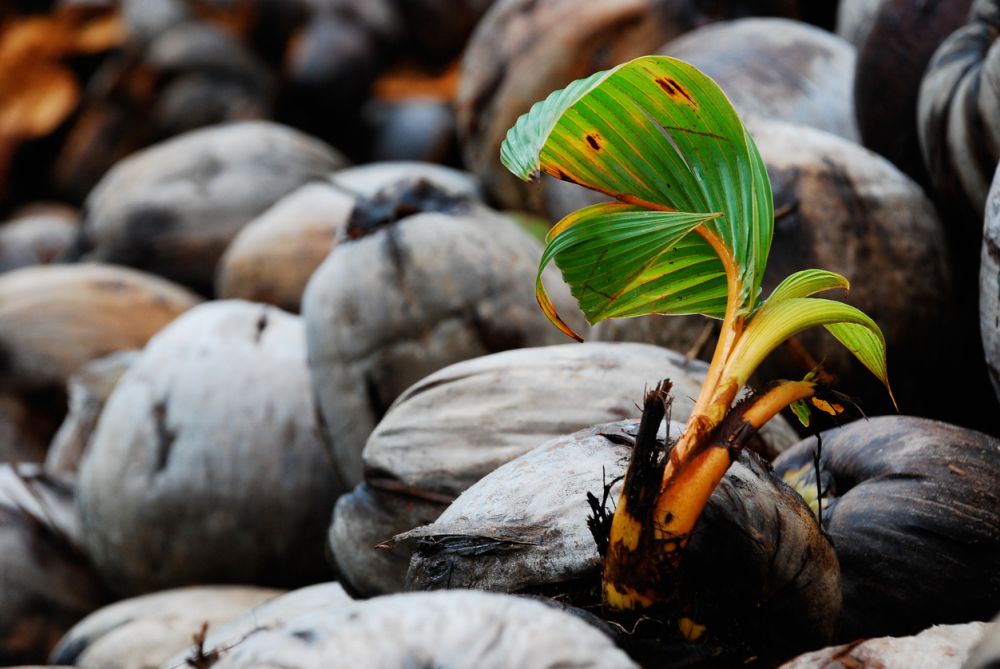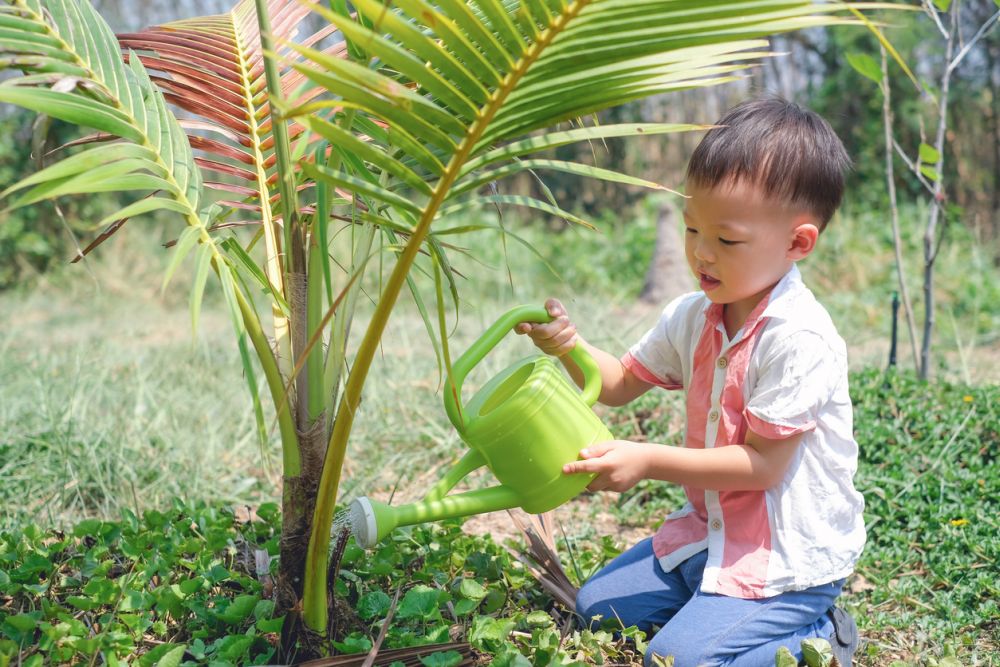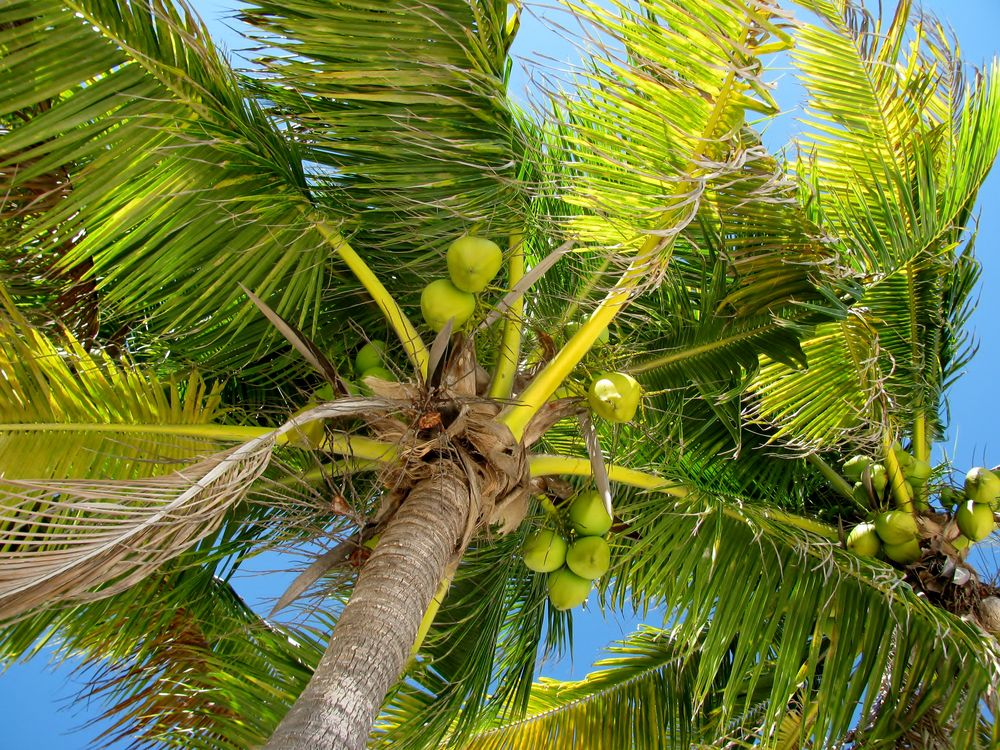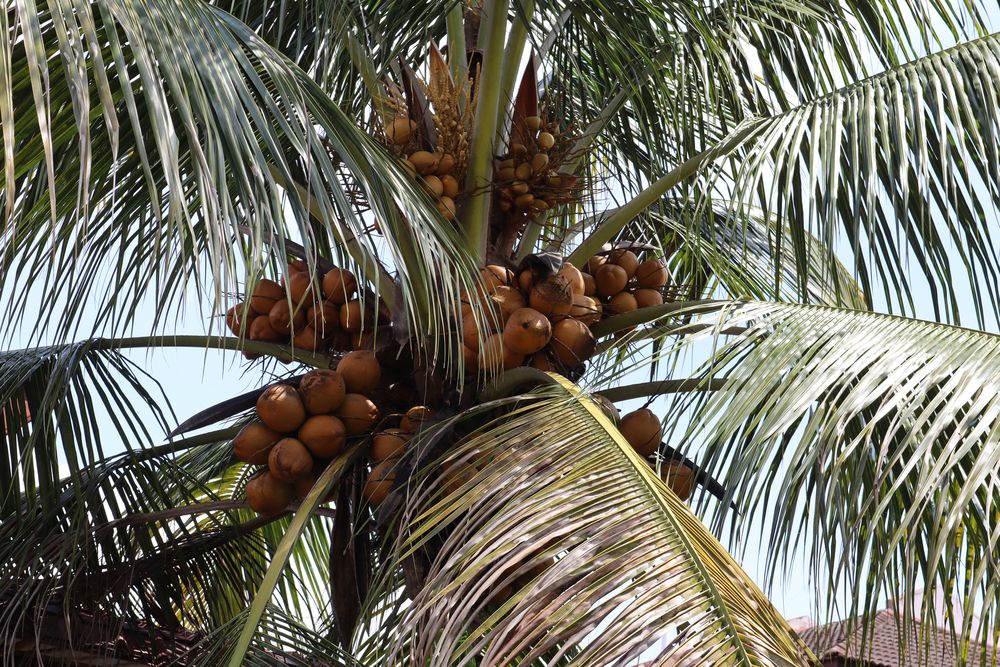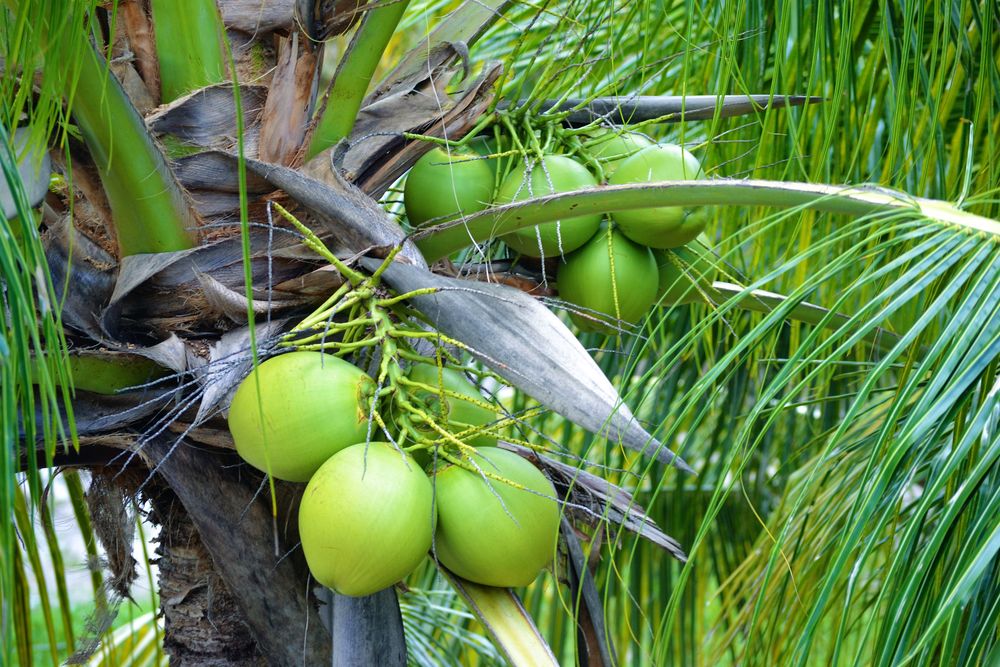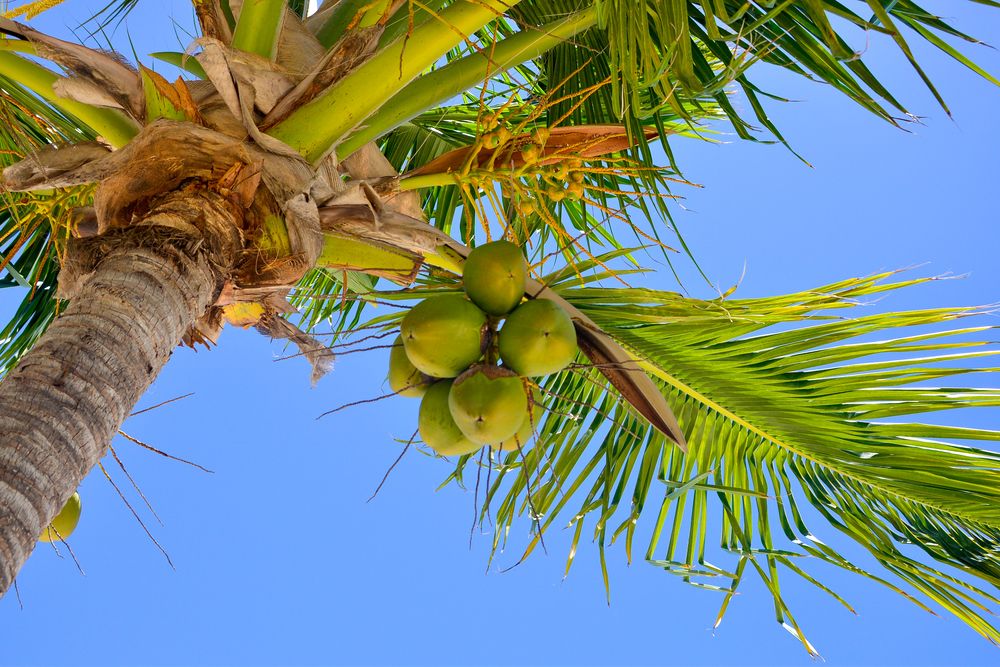Coconut Tree Care: How to Grow and Harvest Coconut Palm
A coconut tree provides years of enjoyment, shade, and beauty in the landscape. But it’s not indestructible and needs maintenance to stay healthy and look its best. Here are our top tips for coconut tree care.
The coconut tree is the ultimate symbol of a tropical island or vacation destination.
It’s a fixture of brochures you find at the travel agent, and your tropical vacation pictures will undoubtedly feature the tree with its merry fronds in the background.
But why go to a tropical island when you can have the coconut palm right in your backyard?
Not only does it look exotic, but you will have a few delicious coconuts every year to make refreshing drinks and tasty dishes.
Read on to find out more about growing and caring about the coconut tree.
Table of Contents
All About Coconut Trees
It was the Portuguese who gave the coconut tree its name. In Portuguese, coco means skull – it refers to the indentations in the coconut fruit that make it look like a face.
A member of the palm family, the coconut palm (Cocos nucifera) can reach 100 feet easily after just a few years of growth.
The fronds are long and measure anything from 13 to 20 feet, depending on the variety. As for the leaflets, they are long and thin, averaging 2 feet.
Not Easy to Harvest
Unlike the date palm tree, the coconut tree has a smooth trunk. When the fronds drop, they don’t leave as much as a scar on the trunk.
This makes harvesting the coconuts a little challenging since it’s not easy to climb the trunk and reach the ripe fruits at the top.
Flowers appear almost all year round, and the same tree will have both male and female flowers. So cross-pollinating is quite easy.
Bountiful Crop
Some dwarf varieties are self-pollinating, making it easier to have fruits even if you only have one coconut palm in the garden.
In the right conditions, you can harvest up to 75 coconuts a year. But more often than not, your annual yield will not exceed 25 fruits.
The ripe fruit is usually bright yellow with greenish or brownish shades. It weighs around 3 pounds on average.
Coconut Tree Uses
Throughout the ages, the coconut tree has proven to be more than just another tree with green leaves and colorful fruits.
And although it doesn’t offer much shade, this palm has sustained whole cultures and offered food, medicine, and shelter.
Here are the top uses for coconut trees:
- Coconuts are 33% fat, packed with energy, and rich in protein, carbohydrates, iron, manganese, and zinc.
- The water is nutritious and refreshing in fruits younger than 8 months.
- Coconut milk is the product of grated and pressed coconut flesh. It goes into many delicious dishes and recipes.
- Coconut flour is created by drying and grinding coconut flesh. It’s keto, and you can use it for baking bread and cakes (e.g. fluffy keto pancakes).
- The fermented water of the young fruit becomes coconut vinegar, which is the backbone of South Asian cuisine.
- Coconut oil has numerous benefits: moisturizes the skin, encourages hair and nail growth, removes makeup, repels mosquitos, and more.
- The trunk of the tree is a source of timber, used to build huts, bridges, and boats.
- The roots of the tree go into many traditional medicine concoctions that treat everything from dysentery and diarrhea to halitosis.
Coconut Tree Varieties
Luckily, not all coconut trees grow to 100 feet. Some are on the dwarfish side and can easily fit into a small space or even in a container.
Here are some coconut tree varieties to consider in your garden:
- Fiji Dwarf: A hardy and disease-resistant tree with a compact size, it’s short but still spreads its canopy far and wide. It has a decent annual yield and can tolerate all types of soil.
- King Coconut: Native to Sri Lanka, this large tree grows to about 60 feet, matures within 8 months, and has an annual yield of 20 coconuts. The water of the young fruits is sweet and refreshing.
- Panama Tall: It’s an elegant tree with a slender and winding trunk that grows to about 90 feet tall. It requires high humidity and warm temperatures all year round.
How to Grow a Coconut Tree
The best way to start growing a coconut tree is by using the fruit. However, not all fruits are good to plant.
To pick the right coconut to grow, make sure it has enough water that sloshes around when you shake it.
Even coconuts purchased from the store are good to plant, as long as the water inside hasn’t dried out.
Here’s how to grow a coconut palm from a drupe:
- After settling on the right coconut to plant, place it in a bucket full of lukewarm water for 2 to 3 days to soften the outer shell. Place a stone on top of the coconut to keep it submerged in the bucket.
- Take the drupe out of the bucket and place it in a plastic bag with one cup of water. Seal the bag and keep it in a warm and dry place for 3 months.
- Roots will develop out of the drupe, and a little sprout will emerge at the top. When the roots are 6 inches long, you can plant the seed in the soil.
- Choose a sunny spot in the garden and till the topsoil 12 inches. Make sure the soil is loose and well-draining. Mix in organic materials and let it sit under the sun.
- Dig a hole in the soil that takes about 2/3 of the nut.
- Place the nut in the hole and spread the roots to fill it up. Keep the pointed end of the seed with the little sprout up.
- Fill the hole with the soil and make it compact around the seed.
- Water the soil immediately. Keep watering it twice a week until you see leaves growing out of the seed.
Coconut Tree Care
Trees are easy to care for, and the coconut tree is no different. The roots grow deep and tap into the moisture trapped in the deep recesses of the soil.
At that depth, the soil is rich, giving the tree a good source of nutrients and reducing the need to fertilize it regularly.
However, as with tropical plants, you need to provide adequate light and temperatures throughout the year.
Here are the correct conditions for growing your coconut tree:
Soil
If you’re growing the coconut tree in the garden, you must amend the clay soil to ensure drainage. Also, the soil must be loose enough so that the roots grow unhindered.
Coarse sand and lime provide the right texture and acidity levels – aim for neutral to acidic, on average.
The coconut palm can theoretically tolerate alkaline soil, but it’s not always easy to get the correct alkaline levels.
And if the soil is naturally alkaline, it’s possible for the alkaline level to increase, which would disturb the tree’s growth in time.So it’s safer to aim for acidic soil pH.
If you’re attempting to grow a coconut tree in a container, use a potting mix with equal parts perlite, peat, and regular soil.
Light
Many coconut varieties are so tall because the canopy at the top is trying to get as many hours of sunlight as possible. So you must choose a sunny spot to grow your palm.
Until the tree reaches full height, there’s always a risk of sunlight getting blocked by higher trees and buildings.
On average, try to expose the tree to at least 8 hours of sunlight in spring and summer.
If you have a potted tree, you can do this easily by moving the container around the sun. However, if winter is always overcast in your microclimate, consider using a grow lamp.
Temperature
The coconut tree requires constant temperatures between 85 and 95 degrees F (30 and 35 degrees C).
This is easy to achieve in zones 9, 10, and 11 since you don’t have to worry about the day or night temperature.As long as it doesn’t drop below 65 degrees F (18 degrees C) at night, your tree will not suffer.
But if you live in zone 9 or below, you won’t be able to grow any coconut variety. In this case, stick to the dwarf coconut tree and grow it in a container – it will thrive year-round, even during harsh winters.
Just remember to bring it indoors before the first frost. Also, use heat mats and grow lights during the fall and winter.
Water
In addition to watering the coconut tree constantly to keep the soil moist, you must use warm water.
Otherwise, cold water will cause the roots to go into shock as the soil temperature drops, affecting the tree’s growth and yield.
Use water between 75 and 85 degrees F (24 and 30 degrees C) to water the coconut tree and allow 1 inch of the topsoil to dry out between irrigations.
But don’t soak the tree since waterlogged soil causes root rot. Also, take rainfall into account when calculating irrigations.
Fertilizer
The coconut tree is a pretty heavy feeder for a tree with sparse foliage. Even established trees will still depend on you to provide rare nutrients such as boron since they struggle with nutrient deficiency, particularly in poor soil.
Choose a liquid fertilizer specially made for coconut palms. The ingredients should include boron, magnesium, nitrogen, and phosphorus.
Apply the liquid fertilizer once every 4 weeks throughout the year as it’s vital for coconut tree care. Also, you can supplement the feeding with slow-release organic compost or aged manure.
Pests and Diseases
The coconut palm sure has more than its fair share of pests and diseases for a tall tree. But since some of those pests only exist in tropical habitats, there’s a tiny chance of you having to fight off the rhinoceros beetle, for example.
Other pests are common in the garden such as mealybugs and spider mites. They won’t hesitate to attack the leaves and feed on the sap, particularly in the first few years when the tree is closer to the ground.
Spray the canopy with neem oil to get rid of these pests since it’s an essential step of coconut tree care.
As for diseases, lethal yellowing is the most dangerous one. It’s caused by phytoplasma, a bacteria transmitted by insects.
Symptoms include leaves turning yellow and fruits dropping before their time. Although it’s treatable with antibiotics (Terramycin), the success rate is pretty low.
The best way to deal with leaf yellowing is to prevent it by regularly removing weeds that host insects.
Harvesting Coconut
You have to be patient when first harvesting the coconut fruits since it takes the tree about 7 to 8 months to yield fruits full of water.
To enjoy fully mature coconuts with their flesh and milk, wait between 10 and 12 months. There’s no harvest date set and, since the tree produces coconuts continuously, you can keep harvesting year-round.
It’s necessary to climb the smooth trunk of the tree to collect the water coconuts. It’s not an easy feat, so you will probably need to hire an expert.
However, if you want to do it yourself, be careful not to drop the nuts to the ground as they might damage. Instead, you should lower them with a rope.
Store the coconuts in a dry place where they can stay fresh for up to 6 months or more; humidity is the number one enemy of stored coconuts.
FAQ
Discover more helpful information about coconut tree care:
How long does it take for a dwarf coconut tree to grow?
Dwarf coconut trees need about 6 years to grow and produce their first fruits.
What is special about coconut tree?
Coconut trees and coconut are incredibly versatile. For instance, you can make brooms from the leaves, use the wood in construction, create bowls and cups from shells, drink the coconut water, or eat the coconut meat fresh or dried.
Which is the best coconut tree?
Many consider the dwarf variety to be the best coconut tree since you can place it in small gardens.
Conclusion
To review, it’s possible to grow coconut trees in your backyard or in a container, particularly if you live in a warm climate.
You have to wait several months to harvest the first crop but it will be worth it since you can take advantage of the numerous health benefits provided by coconuts.
What are your best tips for coconut tree care? Let us know in the comments below!
